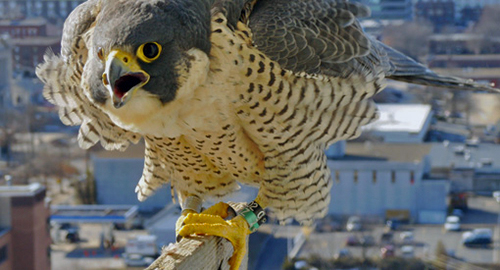Since 1981, NH Audubon conservation biologists and a legion of dedicated volunteers have worked tirelessly to advance Peregrine Falcon population recovery in New Hampshire. NH Audubon first became involved as organized releases of captive-bred falcons were ending and monitoring of wild-breeding pairs began. From a single cliff-nesting pair that fledged two chicks in Franconia Notch in 1981, to 25 breeding territories that produced a record-high 43 fledglings in 2018, NH Audubon observers have been there for nearly 40 years!

The Peregrine Falcon was removed from the federal Threatened and Endangered Species List in 1999, and downlisted from Endangered to Threatened on the New Hampshire T&E List in September 2008. Volunteers can learn more about becoming involved in our on-going monitoring and management of Peregrine Falcons by contacting raptor specialist Chris Martin in the Conservation Department.
Project Leader: Chris Martin
- ConservationOur work in conservation science:Bald EaglePeregrine FalconNorthern HarrierCommon NighthawkSwallows, Martins and SwiftsWhip-poor-willsGrassland BirdsRusty Blackbird ResearchAmerican PipitsCoastal ShorebirdsThe State of the BirdsMotusFarrar Farm Wildlife Crossing ProjectDragonflies and DamselfliesPollinatorsPhenological Monitoring ProjectRaptor MigrationConsultingPublications & Past Projects
Explore our birding-specific websites:
- Education
- Policy
- Lands
- Centers and EventsCentersEvents
- About Us

